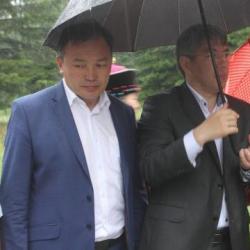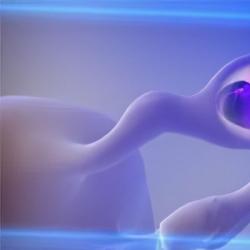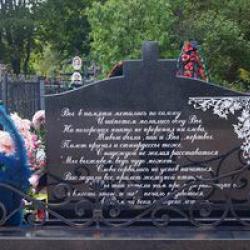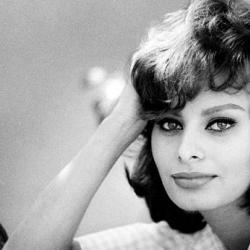Andrea Pejic - biography and personal life. Andrej Pejic, who changed sex, went to a nudist beach (photo) Andrea Pejic's personal life
Andrej Pejic is the only model that looks equally good in both men's and women's clothing. He is a living personification of a new trend - the complete erasure of boundaries and differences between the sexes. ZEITmagazin: Who do you feel like? Man or woman? Andrei Pejic: Sometimes I feel feminine, sometimes more masculine. Despite the fact that people see me as more feminine, I feel two genders in me at the same time. And at the moment, I'm comfortable in this state. Z: When did you discover your feminine side? A.P.: As a child, I was very interested in my mother's wardrobe. It was very touching for everyone and not shocked at all when I was little. But with age, I had to understand that there is a certain boundary between what is considered masculine and what is feminine. Z: So, over time, you stopped touching those around you with your feminine behavior. A.P.: Yes. Over time, it became abnormal to play with dolls and put on makeup. Somewhere around the age of 8-12, I was desperately trying to become a boy. Z: You were born in Bosnia immediately after the war and lived in Serbia until the age of eight. It seems to me that such an environment was not conducive to the knowledge and acceptance of one's true sexuality ... AP: Yes, Serbia is not the most tolerant country. But as a child, I was very nice, and everything was forgiven me. Everything has become much more difficult with age. And I am very grateful to my mother, who was always on my side and protected me from the attacks of others. Z: Tell us about your family? AP: My father was an economist. Now he works in the tourism business in Bosnia. My mother was a lawyer. When we moved to Australia, she retrained as a teacher. Z: Were you middle class? A.P.: Yes, but after the war we became poorer. Z: Did you have difficulty adjusting to a foreign country? AP: Yes, it was very hard for me. Australia did not provide immigrants with any adaptation courses in a new place. I went to school without knowing English. But it is easier for a child to survive this situation than for an adult. It only took me a year to learn a new language. Z: When did you first get interested in fashion? AP: I started reading fashion magazines at an early age and have loved shopping since childhood. But I never thought about a modeling career. Z: You've been modeling for a year now. Tell me how you got noticed? AP: I used to sell fruit at a market in Melbourne. An agent approached me and bought strawberries from me. Then he asked if I would like to go with him to the agency. Z: He thought you were a girl? A.P.: Yes. The fact that I'm a guy, it turned out only in the agency. But that only intrigued him even more. Z: Strange, I read that the agent spotted you at the airport. A.P .: To be honest, I get asked this so often that I began to change the stories so that it would not be so boring to tell. But each of them has its share of truth. Z: At the moment you are the only model who participates in both men's and women's fashion shows. When was the first time you walked the runway in women's clothing? AP: I've done women's shows for some Australian designers. But my biggest show for women was the Gaultier show in Paris in January. It took a long time for people to realize that I could show clothes for women. Many thought that my body was not suitable for this. But as you can see, it fit. Z: What is the difference for you as a model between male and female shows? AP: Women's fashion is more demanding. At the women's show, a lot of attention is paid to how you walk and how you move. At the men's show, you just walk through and that's it. Z: Can you psychologically switch between images of a man and a woman? A.P .: I start from who others want to see me. In the female image, I am more sensual and sexy, in the male image, I am ordinary. Z: For you, being a man means being ordinary? A.P.: In the fashion industry, it is. Men are less interesting than women. Z: How do other models react to you? AP: They are very loyal to me. I can’t say that they behave like my best friends, but they don’t put a spoke in the wheel either. In men's shows, I'm usually the most feminine model. But courageous models are not at all embarrassed. Z: Describe your everyday style. AP: I wear both men's and women's clothes. But I noticed that you can dress well and for less money only in women's clothes. Good men's clothing costs a lot of money. Z: Do you wear dresses? A.P .: If I liked some kind of dress, then I will put it on without hesitation. I also wear high heels. Z: And the make-up? AP: Not too strong. I'm not a transvestite and I don't want to be reincarnated as someone I'm not. Z: Let's say you walk into a club in heels and a man treats you to a cocktail. How long will it take for you to tell him you're not a girl? AP: This happens to me all the time. But before you go to him or to me, I will definitely inform you that I am not a woman. Usually, this doesn't bother anyone. Z: Do you prefer men or women? A.P.: Let's put it this way. I believe that love has no boundaries. Source zeit.de Updated on 11/03/11 11:10: Translation www.face.ru
(nee Andrej Pejic) - a transgender model of Serbo-Croatian origin. For a long time, Andrej Pejic was a sought-after fashion model, known for his androgynous appearance, and successfully participated in shows of both men's and women's collections of famous fashion houses. In 2014, Pejic underwent sex reassignment surgery and asked to be identified as Andrea.
Height: 188 cm;
Hair color: blond;
Eye color: brown;
Zodiac sign: Virgo.
Biography and career of Andrei
Andrei Pejic was born on August 28, 1991 in Tuzla(Bosnia and Herzegovina) in the family of a Serb and a Croat. When Andrei turns 8 years old, as a result of the military conflict in Yugoslavia in the 90s, the family emigrates to Australia, to the city of Melbourne.



As a teenager, Andrei, on the advice of friends and relatives, sent several of his photographs to various modeling agencies at random. He didn't even think about possible responses. In 2008, the young man was noticed by Matthew Anderson, head of the Melbourne branch of Chadwick Model Management, who found that he was remarkably similar to one of his models. So Andrey received a job offer in the field of fashion. However, he did not start work immediately.
“I knew that London, Paris and Milan would want him right now. But it is important to understand that everything needs to be done slowly: in the right place, at the right time. Care must be taken, life in this business can be very short if opportunities are not handled wisely. Once you start using them excessively, and that’s it, you will run out of steam in a two-year period.”
Matthew Anderson
In May 2009, at one of the Sydney Fashion Week shows, the first public the emergence of Andrei Pejic as a fashion model. The young man instantly riveted the attention of the perplexed public. The audience for a long time could not understand how the girl ended up among the models of the men's clothing line. Upon learning that a young man was parading in front of them, many were perplexed.



In February 2010, Andrei arrives in London and there he signs a contract with Storm, from that moment representing his interests in London (at one time they also promoted the world famous one). Two days after the event, Andrey is working on the set for Dazed & Confused magazine. Then they were presented in the magazines "Arena Homme +", "Oyster" and "Paris".
In Milan, Pejic begins to represent I Love Models Management, and in Paris, the young man works with New Madison.



In April 2010, Wonderland Magazine was released, in which Pejic also participates in the shooting - "Smell the Smell".
June 2010 as part of Paris Fashion Week Andrey participates in men's shows collections spring-summer 2011. Among them are the Jean Paul Gaultier show, in which Andrey had three exits, including the closing show; John Galliano; Raf Simons; .
So Andrej Pejic gets into the top ten newcomers of the season on the website "models.com".



Then the young man signs a contract with New York "DNA", Milan "D'management", Tokyo "Bravo" and others. Pejic works with photographers such as Matthew Brooks, Steven Meisel, Juergen Teller, Anthony Mauli, shoots for Japanese Vogue Hommes, Italian, French and Turkish Vogue, i-D, Dossier and many others.
In January 2011, model Andrej Pejic completes the show of the Jean Paul Gaultier Couture spring-summer 2011 women's line with his appearance in a wedding dress, becomes the face of the brand's advertising campaign and takes part in a photo shoot.
"This is the most beautiful girl I have ever seen in a wedding dress!"
Jadranka Pejic (mother)


At the autumn-winter 2011 shows, Pejic represents the men's lines of Z Zegna, Jean Paul Gaultier, Robert Geller, Neil Barrett, Comme des Garçons, Custo Barcelona and others, as well as the women's lines of Kimberly Ovitz and Jeremy Scott.
In April 2011, Andrej Pejic ranked 11th in the list of the most sought-after male models in the world according to models.com



In 2010, on the pages of the November Vogue Italia, a studio photo shoot "Venus in Furs" was published with the participation of Andrey Pejic, Freya Beha Eriksen, Alla Kostromicheva, Iselin Steiro, Tomek Schuketsky. Steven Meisel captured the semi-naked bodies of models covered with fur.



In 2012, on the pages of the spring-summer Candy Magazine, Andrej Pejic appeared in female and male images. Adrej Pejic and Ginta Lapina took part in the shooting of Sebastian Kim's Twins for the November Numéro. For the pages of the November Out Magazine, Pejic posed naked on the floor with a python. Andrej Pejic appeared on the pages of the December issue of Dujour. Tony Kim's photo session was dedicated to Warhol and his muses. Andrey tried on the images of Edie Sedgwick, Nico, Candy Darling and Andy himself.



In 2014, the women's jewelry collection Pejic x Snyder, created by Andrej Pejic for the Sam H Snyder Design brand, was presented. It includes 10 products: cuffs, bracelets, necklaces, several models of rings. Each jewelry was offered in 4 versions: silver, palladium, platinum and white gold. The cost of one item, depending on the metal, ranged from 200 to 70,000 dollars.


sex change
Despite the fact that Pejic himself has long claimed that he is comfortable in his own body and he is not going to change anything, in 2014 the fashion model officially announced that he had undergone a sex change operation. Pejic did not radically change her name, she only asked to be called Andrea, not Andrey.
In 2015, after undergoing a course of postoperative rehabilitation, Andrea Pejic returned to her modeling career. In February 2015, the girl took part in the Jean-Paul Gaultier show, and in the spring of the same year, she starred in an advertising campaign for the cosmetic brand Make Up For Ever.


- Andrew is an atheist.
- Among his interests are the works of David Bowie, Michael Jackson, Amanda Lear, Salvador Dali, Boy George and, he loves the 1980s, New Romantics, biology and music festivals.
- Even at the age of 15, Andrei began to be interested in the history of communism and socialism, considered Karl Marx his hero, followed his teachings, and was an active participant in the meetings of the Socialist Equality Party.
- Favorite book is Anna Karenina by Leo Tolstoy.
- He considers his own birth to be his greatest achievement.
 Andrej Pejic (interview with Vanity Fair magazine)
Andrej Pejic (interview with Vanity Fair magazine)
Vanity Fair: You said you love eating pasta. How do you manage to stay in shape after it?
I do sports.
Vanity Fair:How do you think, why so much attention to your person?
The era we live in is very boring, people have no desire to experiment. Maybe I'll break this reality. I am young, full of enthusiasm and determination, I cultivate my uniqueness, because I managed to enter a world that allowed me to transform myself.
Vanity Fair:Androgynous, transsexual - these are the terms that usually come up when talking about Andrey Pejic. How do you define yourself?
If we are talking about sexual orientation, I will say that love has no boundaries. Actually, I am alone. I think that I am not very attracted to sex, only if there are feelings. But if we mean my gender, then I will say that I get along very comfortably with my ambiguity. I understand that I look very feminine, and this applies not only to the appearance, but also to my lifestyle.
Vanity Fair:Can you tell a little about your life?
I was born in Bosnia, two months before the start of the war. My father is a Croat, my mother is a native of Bosnia. When I was 8, I moved to Australia with my mother, grandmother and brother. My father didn't come with us. Now he lives in Croatia, his activities were related to the economy, now he has been unemployed for many years. My mother was a lawyer, and in Melbourne she began to work as a school teacher. Vanity Fair:Has she ever been against you expressing yourself in such an unusual way?
My mother is very modern: She loves her children so much that it is very easy to accept us as we want to be. By the way, now she is my passionate admirer. Even my 21-year-old brother, who is straight and is studying to be a construction worker, supports my position. Vanity Fair: Who did you admire as a child?
David Bowie, Amanda Lear, Boy George, even Salvador Dali and Madonna. It was the 80s and someone's strangeness did not make people wonder the way they do now.

Vanity Fair:Has uncertainty always been your source of inspiration?
I think so, even when I didn't feel it. When I reached adolescence, I was unable to hide it, and my body did not help me in this. I never had acne, and my voice remained feminine, high. I loved dressing up and started bleaching my hair.
Vanity Fair: And what about a beard? How did you make her and all the other hair on your body disappear?
I have never disdained plastic surgery and other tricks that women resort to to look good.
Vanity Fair: You said you believe in love. Did you have her? Have you met someone?
Yes, of course, I met. But I'm not sure I was in love. Being together is great, but you need to participate in the life of your soul mate. And I am an autonomous person, that is, I do not know how to love completely.
Vanity Fair:Maybe you had an affair in high school?
Yes, but don't ask me if it was a boy or a girl, because I already said that for me love has no limits. I admit, I really enjoy arousing all this interest in my orientation, so I can't tell you for sure. And to some extent, because I myself do not fully understand this yet.
Andrej Pejic (interview for ZEIT Magazine. February 2011)
ZEIT Magazine:Mr. Pejic, do you yourself feel like a man or a woman?
Sometimes I feel more masculine and sometimes more feminine. You can think of me as a more feminine person, but in reality I am both. And at the moment I am very comfortable in this state.
ZEIT Magazine:When did you first discover your feminine side?
When I was little, I was very interested in my mother's wardrobe. When you are a child, everyone thinks it is very cute. It wasn't until I got older that I realized there was a very thin line between boys and girls.
ZEIT Magazine:And then it stopped being cute?
No, it was already strange, because I continued to play with dolls and put on makeup. Between the ages of 8 and 12, I really tried to be a real boy. But it didn't work.



ZEIT Magazine:You were born in Bosnia shortly before the start of the war and lived in Serbia until the age of 8. It seems to me that that environment was not very favorable for the kind of sexual self-discovery that was happening to you.
Serbia was and remains not a very tolerant country. But I was a very sweet child and I was easily forgiven for my pranks. It got harder as I got older. I am very grateful to my mother who protected us and helped us through it all.
 ZEIT Magazine: Describe your parental home?
ZEIT Magazine: Describe your parental home?
My dad was an economist. Now he works in the tourism business in Bosnia. My mother was a lawyer and when we moved to Australia she went to school and is now a teacher.
ZEIT Magazine:So your family is middle class?
Now yes, but after the war my family was in poverty. I feel more like a child from a working class family.
ZEIT Magazine: Was it difficult to get your bearings when you moved to another country at the age of 8?
Yes, it was hard. There were no integration courses for emigrants. I went to school without really knowing English, and I tried to catch something in the process of studying. But when you are a child, everything is easier. I mastered a new language in just a year.
ZEIT Magazine: When did you start getting interested in fashion?
I started buying and reading fashion magazines very early and I have always loved shopping. But I never dreamed of becoming a model.
ZEIT Magazine: You have been modeling for about a year. How did you get into this business?
I worked at a market in Melbourne selling fruit. A modeling agent bought strawberries from me and asked if I would like to come to the casting in his agency.
ZEIT Magazine:He then did not understand that you are not a girl?
They understood this only later, when I came to the agency. But they found it even more interesting.
ZEIT Magazine:And I read that you were noticed at the airport in Melbourne ...
You know, I get asked so often about how they found me that I sometimes change versions just for fun. Every story has its own truth.
ZEIT Magazine: At the moment, you are the only fashion model so busy showing both men's and women's clothing. When did you first take part in a female fashion show?
I have worked for several Australian brands, but my first big show was Jean Paul Gaultier at Paris Fashion Week. It took a while for people to believe that I could actually work in women's shows. Many doubted that my body would allow me to do this. As you can see, it allowed.
ZEIT Magazine:Is there a difference in working for women's and men's shows?
Women's fashion is more demanding. The important thing here is how you move, how you walk… In the men's shows, you just run back and forth along the catwalk.
ZEIT Magazine: Can you switch from male to female and vice versa if needed?
I know what others expect from me. As a woman I am sexy and sensual, as a man I am simple.
 ZEIT Magazine:So, being a man means being ordinary?
ZEIT Magazine:So, being a man means being ordinary?
When it comes to fashion, yes.
ZEIT Magazine: How do other models react to you?
They are very kind to me. Not best friends, of course, but they don't act bitchy... In men's shows, I'm usually the only feminine fashion model. But even very courageous models are calm about this.
ZEIT Magazine: How do you usually dress?
I wear both men's and women's clothes. But looking good as a woman is less expensive. Good men's clothing is very expensive.
ZEIT Magazine: Do you wear dresses?
If I see a dress that I like, I wear it. I have no problem with this. I also wear high heels.
ZEIT Magazine:How about makeup?
I use them to a minimum. I'm not a transvestite and I don't want to turn into someone else... I'm a natural.
ZEIT Magazine:When you put on high heels and go out into the world, and a man treats you to a cocktail ... When do you admit that you are not at all what you seem at first glance?
I have had many such situations, but I have never invited a person home without telling him that I am not a woman. But for many it doesn't even matter. They will still treat me to cocktails.
ZEIT Magazine: Do you prefer women or men?
I will answer as follows: love has no boundaries.
Andrej Pejic DNA for Dossier Journal
Andrej Pejic
Andrej Pejic on Sunday Night
Andrej Pejic para MANGO





Andrej Pejic in Garage Magazine (2012)


Andrej Pejic in the Silvian Heach advertising campaign (autumn-winter 2012-2013)









In 2014, Andrej Pejic, an Australian fashion model of Serbian-Croat origin, underwent a sex change operation and became Andrea. And only 2 years later, after a long rehabilitation, the model decided to go out in a swimsuit, and two years later without.
Grade
On Instagram, she told fans that she had visited a nudist beach for the first time. The transgender model shared a photo in which she is completely naked.
The picture was taken on the beach in Melbourne, where Andrea spends the New Year holidays with her family.
It is worth noting that last year Pejic became the first transgender model in the world to sign a contract with the elite modeling agency Ford.
Born in Yugoslavia, more precisely in Bosnia and Herzegovina, in 1991. His mother is Serbian and his father is Croatian. In 1999, Pejychi became political refugees and fled the bombings to Australia.

From childhood, Andrei was cute and looked like a girl. The family accepted Andrei for who he is. When asked if you have a grandson or granddaughter, Pejic's grandmother answered: "I have both!"
In an interview with People, Pejic said that since childhood she dreamed of becoming a girl.

At the age of 17, Andrey got into the modeling business and was quickly noticed by famous designers.
Andrea Pejic made a lot of noise among her many subscribers by posting a photo in which she was completely naked. However, the model still covered all the strategically important places with sparkles. “A girl named Shame wanted me to wear more clothes, but I threw everything off,” Andrea captioned the photo flirtatiously.
ON THIS TOPIC
Numerous subscribers were indescribably delighted to see the nude model. Fans showered the fashion model with compliments, appreciating the form of 25-year-old Pejic.
"Incredible", "I'm blown away", "Always beautiful", "Oh my God, girl, I took my breath away from your beauty!", "It's too late to be embarrassed", "Oh-fi-get! I'm envious at all!" - so sounded only part of the enthusiastic reviews of fans.
The most piquant thing in all this is that Andrea Pejic is by nature ... a man. The future star of the world catwalks was born in Bosnia in 1991. When the boy was eight years old, his family fled the military conflict in the country to Australia. Already nine years later, Andrei (the real name of the model) was noticed by one of the modeling agencies, which was attracted by the androgynous - universal - appearance of the boy.
Since then, Pejic has been in great demand and has been featured in both men's and women's fashion shows for the world's leading brands. Andrey's appearance became so popular that the fashion model appeared on the pages of many fashion magazines, including Vogue. Moreover, Pejic was popular precisely in women's fashion. As a result, in 2014 the fashion model finally changed his gender and chose the name Andrea.
Most of his life, Andrej Pejic lived in a male image. He was born in Bosnia and Herzegovina in 1991 to a Serbo-Croatian family, who soon had to flee because of the outbreak of hostilities. The head of the family remained at home, and mother Andrea and her children moved to Australia.
In numerous interviews, Andrea Pejic admits after the sex change that even as a child, she preferred defiling in her mother's outfits and testing cosmetics to traditional boyish games.

Andrey Pejic before the operation often became the object of ridicule of peers because of the pronounced resemblance to the girl. Classmates made fun of Andrei, but he was calm about ridicule.

Andrey Pejic's modeling career began after sending photos to the Melbourne branch of the international agency Chadwick Model Management, whose representatives immediately saw the future star.

The androgynous model Andrei Pejic, if he did not make a revolution in the modeling business, then definitely made a splash.

Andrej Pejic studied the art of modeling for several years before the operation and in 2009 became a real star at Sydney Fashion Week. At the beginning of his career, Pejic participated in both women's and men's shows, which brought him unprecedented popularity.

By 2011, Andrei was in the spotlight at the Paris Fashion Week, as a favorite of Marc Jacobs and Jean-Paul Gaultier.

Andrej Pejic's career before the operation is associated with several high-profile scandals. In 2011, a topless photo of Andrei Pejic appeared on the cover of Dossier magazine and provoked a wave of condemnation for his too obvious resemblance to a woman. The American chain of bookstores refused to sell the magazine, and the publicized situation fueled interest in both Andrej Pejic and the publication.

Another case is related to FHM magazine, which included Pejic even before the operation in the hundred most beautiful women according to readers. His name was removed from the printed version of the magazine, but kept online with the editors' apologies.






